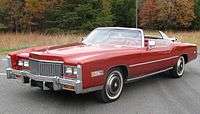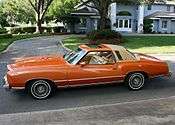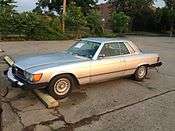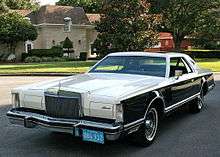Personal luxury car
.jpg)
A personal luxury car is an American car classification describing a highly styled, mass produced, luxury vehicle with an emphasis on image over practicality. Accenting the comfort and satisfaction of its owner and driver above all else, the personal luxury car sometimes sacrifices passenger capacity, cargo room, and fuel economy in favor of style and perceived cachet, as well as offering a high level of features and trim.[1] Typically employing a two-door platform with common mechanical components beneath their distinctive exteriors, these vehicles were a profitable segment of the post-World War II automotive marketplace.
In the U.S., the four-seat 1958 Ford Thunderbird (second generation) launched the personal luxury car as a major market segment, according to most auto historians.[2][3][4]
Characteristics

Personal luxury cars are characteristically two-door coupés or convertibles with two-passenger or 2+2 seating. They are distinguished on the performance end from GT and sports cars by their greater emphasis on comfort and convenience. Even though they usually contain higher horsepower engines and the necessary support systems for the higher horsepower output (transmissions, tires, brakes, steering, etc.); these larger power trains usually only bring these vehicles back to the power-to-weight ratios that they would have had if their gross vehicle weights had not been increased to accommodate the installation of their luxury features and accessories. On the luxury scale, by their appointments, features, and style, there is great variability within the market; however, this is not absolute but merely a general trend.
Personal luxury cars are mass-produced, not coach built, and typically share all of their chassis, power train and all other major mechanical components with high volume sedans to reduce production costs, and to ensure that their per unit profitability is extremely high; to both the manufacturer and the selling dealer. Typically, the per unit profit of the sale of a new personal luxury vehicle is measured in thousands of dollars to both the manufacturer and the dealer, while the sale of a new compact or intermediate sedan yields only a few hundred dollars in profit per unit. However, they have additional styling elements and sometimes "baroque"[5] designs. They are typically equipped with as many additional features as possible, including power accessories such as windows, locks, seats, antenna, as well as special trim packages, leather upholstery, and heated seats.
Pre-Ford Thunderbird
Origins
Pre-WW2 - personal or specialty cars
During the 1910s, "the personal car took the form of a low-slung runabout, relatively light in construction, but relatively powerful in nature. In the Twenties, these runabouts became roadsters, still with the light-but-powerful connotation."[6]
In the ultra-luxury segment, antecedents of the concept are the highly expensive, often custom-bodied sporting luxury cars of the 1920s and 1930s. Typically made by Alfa Romeo, Bugatti, Delage, Delahaye, Duesenberg, Mercedes-Benz, Lincoln, Cadillac, and others, these extremely stylish prestige cars were favored by film stars, aristocrats, playboys, and gangsters for projecting dashing and extravagant images. Two extreme examples were the Duesenberg Model SJ and Mercedes-Benz SSK, extremely fast and expensive automobiles which eschewed both pure luxury and absolute sports performance in favor of a distinctive combination of style, craftsmanship, and power: these combined to produce cars that became status symbols.
Luxury in the 1950s
The Great Depression and World War II temporarily eroded the market for these expensive bespoke cars before post-War recovery saw a reemergence in Europe. On the sedate end of the spectrum appeared such erect yet swift premium ultra luxury two-door sedans, such as the H.J. Mulliner bodied, straight-6 powered Bentley Continental R Type. On the other, performance oriented GTs, relatively comfortable low-slung cars intended for high-speed, long-distance travel. France, successful in this segment before the war, chose to exit the market by applying strict tax horsepower regulations. Italian marques such as Ferrari and Maserati took the GT lead, offering distinctive, often custom-bodied two-seat and 2+2 coupes powered by exotic alloy-lightened engines straight off the race track. In between could be found such combinations of luxury and performance as the Mercedes-Benz 300SL and 190SL, BMW 507, Alfa Romeo 1900 Sprint, and DKW 1000Sp. These were all very high price Veblen goods.
Luxury and reliability over sport

With both custom luxury cars and GTs beyond the reach of all but the wealthiest, the 1950s saw a growing trend in both the United States and Europe towards mass-market "specialty cars" catering primarily to drivers coveting the image of bespoke machinery without its cost. Joining them were affluent buyers who could afford the genuine article but disliked the inconvenience of complex service and repair, especially in areas where exotic car dealerships were few and far between. Many of both classes were also interested in such modern conveniences as automatic transmission, air conditioning, power steering, and other comfort options not generally offered on GTs or sports cars of the day."[7]
.jpg)
The result was a burgeoning market for so-called "factory customs," models using standard or mostly standard engines and other mechanical components, but with unique styling on a full-size car platform. A prominent early example was the 1953 open top Cadillac Eldorado, where customized styling gave it a price tag nearly twice that of a standard Cadillac convertible despite nearly identical underpinnings. GM's Buick division also offered the Roadmaster Riviera coupe as its top level luxury coupe in 1954. Packard introduced a large 2-door luxury coupe called the Packard Caribbean in 1953.
In 1955, Chrysler introduced the 300 series 2-door coupe, with a powerful 300bhp engine, giving the car its name. There was a mid-size car aimed at this market as well - the 1956 Studebaker Silver Hawk range of two-door 2+2 performance hardtops in the GT tradition. The automaker Studebaker ceased operations in 1963.
1955 Ford Thunderbird
.jpg)
The first step to the evolution of the personal luxury car as a mass market segment in the United States was Ford Motor Company's two-seat 1955 Thunderbird. Ford termed the 1955 model a personal car. [8]
During the Second World War American servicemen stationed in Europe began to experience the benefits of the nimble sports cars, particularly in Britain, and many shipped them home on their return.[9] US automakers responded with a pair of home grown two-seat models, the sporting Chevrolet Corvette, a fiberglass-bodied 6-cylinder roadster with few creature comforts introduced in 1953, and the larger, more comfortable, existing component-based Ford Thunderbird.[3] The Thunderbird was a softly sprung car, with a powerful V8 engine, that came both as a convertible and roadster with removable hardtop.
The model sold 53,000 units, achieving niche success for a two-seat car.[3]
1956 Continental Mark II

Ford Motor Company also tried creating an ultra-luxury vehicle with the 1955 introduction of the near bespoke Continental Mark II. The Mark II was only available as a 2 door coupé. Nearly handmade, the Mark II sold for around $10,000,[10] the equivalent of a new Rolls-Royce or two Cadillacs. 3,000 Mark IIs were sold over three years from 1955 to 1957.
In 1957, Cadillac pursued a similar ultra-luxury vehicle, the Cadillac Series 70 Eldorado Brougham. It was available only as a four door sedan, also met with modest success, and was not carried forward beyond 1960.
The Mark II was an attempt by the newly-created Continental division of Ford Motor Company to offer a car not only to rival the greatest American and European automobiles of the pre-War era but anything built after. It came equipped with nearly every conceiveable luxury as standard equipment – power steering, power brakes, power windows, power seats, power vent windows, leather interior, and a tachometer – it had only one option: air conditioning for $595.[11]
The Mark II remains a rare and elegant classic, coveted for its simplicity of line and understated grace. The exclusive 2+2 Continental Mark II was replaced by a gaudy, over-sized Lincoln Division-produced Mark III, still way beyond the Thunderbird both in dimension and price. The Mark name was used from 1958 to 1960 (Mark III, IV, V) and then retired until 1969's Lincoln Continental Mark III.
1958 Ford Thunderbird
.jpg)
In 1958, Ford managed to combine the personal car with the aura of a luxury 2 door coupé into one car, the Thunderbird, and achieved such a level of success that other automakers had to respond. This was the beginning of the personal luxury car market segment.[4][12]
This car sold 200,000 units over three years - four times the results for the earlier two-seat model. As a result of their own surveys, Ford decided the 1958 Thunderbird should gain rear seats, a permanent hardtop, and 800 lb (360 kg).[12] The new four-seat model was equipped with numerous comfort, luxury and convenience features of a full-size car in a mid-size car that was easier to park and manipulate in congested areas.[4] The car was powered by a 300 hp (220 kW) V8 engine, making it swift in traffic.[4]
So revolutionary was the personal luxury car concept, that the Thunderbird won the 1958 Motor Trend Car of the Year award in the U.S.[4]
Expanding market in the United States
.jpg)
.jpg)
Early competitors
The four-seat Thunderbird's sales increased, but the other American auto manufacturers were slow to react.
In 1962, GM's Pontiac introduced mildly sports oriented cars - the full-size Grand Prix and Buick the Wildcat, but neither replicated the "luxury" side of the mid-size Thunderbird formula.
In 1962, Studebaker introduced the Avanti, featuring an exotic Raymond Loewy designed fiberglass body and supercharged engine mounted on a modified 109-inch convertible chassis and innovations such as front disc brakes. The company was only able to build 4,100 Avanti cars before it closed in 1963, and sold its dealership network to Mercedes-Benz.
In 1963, Buick introduced a new 2+2 coupé, the evocatively named Riviera, which "set new heights for a personal luxury car."[13] Its success soon spawned other rivals from GM, the long-hood, short-trunk front-wheel drive Oldsmobile Toronado appearing in 1966 and a similarly reconfigured Cadillac Eldorado in 1967.
The expanding specialty car demand, including the pony car, also influenced the development of personal sports models such as the fastbacked American Motors' 1965 Marlin, Dodge's 1966 Charger, and Mercury's Cougar in 1967.[14] Both the Marlin and Charger were based on a generic intermediate platform given distinctive styling features and room for just four passengers.[2]
Initially, industry sources such as Ward's Automotive Yearbook classified the expanding class of widely varying long-hood/short-deck models "specialty cars", which grew by their count from eight makes in 1966 to twelve in 1967 — Corvette, Camaro, Riviera, Eldorado, Mustang, Thunderbird, Cougar, Barracuda, Charger, Marlin, Toronado, and Firebird.[15]
Wider number of segments - from mid-range to top-range
The personal luxury market became so significant and highly competitive that it was divided into size and price market segments, from moderate price/compact to premium/full-size.
In 1967, the Thunderbird, "long predominant in the field", was "sharply restyled and has added a four-door model for the first time" as the Ford Thunderbird (fifth generation).[14] Filling in the Ford range was the 1967 Mercury Cougar based on a stretched Ford Mustang platform, with focus on luxury and distinguishing styling features such as hidden headlamps and sequential rear turn signal lamps.
Oldsmobile added its Toronado in 1966, and Cadillac the 2+2 styled Eldorado a year later. By 1967, Motor Trend magazine was able to state: "Motorists of just about every stripe can now find a car with pleasing and distinctive lines, good performance and all the things that go to make a car enjoyable."[7]
In 1969, the upscale Lincoln Continental Mark III was introduced, using the Ford Thunderbird (fifth generation) chassis, and was the first American-made vehicle with the technically superior radial tire as standard equipment.[16]
European competitors - Grand Turismo
Imported vehicles were a very small segment of the US market until the late 1960s. In 1966, the Big Three (GM, Ford, Chrysler) had market share of 89.6% (44.5% in 2014).[17] From 1966 to 1969, net imports increased at an average annual rate of 84%.[18]
European Gran Turismo or 'GT' cars found increasing U.S. acceptance in the 1970s, as part of this growth, with models like the BMW CS coupes, Citroën SM, and third-generation Mercedes SL roadsters. Mercedes-Benz came to dominate the upper end of the personal luxury sector, with 300,000 R107 SL and C107 SLC models sold between 1971 and 1989, 2/3 in North America.[19]
New models in the 1970s
The decline of the muscle car, due to rising insurance costs and emissions standards in the early 1970s, coincided with a strong upswing in the personal luxury segment, as American buyers shifted emphasis from performance to comfort.[20] Offsetting this, the 1973 and 1979 oil crises impacted demand for cars with relatively poor fuel economy.[21]
Chevrolet introduced the 1970 Monte Carlo using an intermediate-sized chassis, which was "scaled down in opulence from the similarly-bodied Pontiac Grand Prix offering buyers elegance and prestige".[22] "Ford might have created the personal luxury car with the Thunderbird and Continental Mark II, but it took Chevrolet and Pontiac to take personal luxury to the masses."[23]
By 1972, the Ford Thunderbird (sixth generation) was heavier and more expensive than competitors that included the Riviera, Toronado, Grand Prix, Cougar, Chevrolet Monte Carlo, AMC's Oleg Cassini Matador, and even Ford's own Torino Elite.[24]
In 1975, Chrysler introduced the Cordoba, the company's first coupe produced specifically for the personal luxury market, although they had earlier declared that there would "never" be a smaller Chrysler.[25] These models enjoyed impressive sales figures in the mid-1970s with their intimate, luxury-oriented feel, plush interiors, and mostly vintage styling cues like Rolls Royce-style radiator grilles, opera windows, and vinyl roofs. The new Cordoba finished second to the Chevrolet Monte Carlo in sales for that segment.[26]
Japan
This marketing approach was also used in Japan, where in the early 1970s saw the introduction of the Toyota Crown coupe, followed by the coupe versions of the Nissan Cedric and Nissan Gloria, and the Mazda Luce. In the 1980s the Toyota Soarer, Nissan Leopard, Mazda Cosmo, and the Honda Legend were popular with Japanese buyers.
Decline

American 'personal luxury' cars grew ever larger, heavier, and more luxurious, and were typically equipped with either a V6 or a V8 engine, both less powerful due to early designs of emissions control systems. These cars retained their poor fuel economy, faced an industry switch to smaller cars and front-drive architecture, and changed consumer demand, that renewed emphasis on utility over image during the early 1980s. In 1981, sales of the Cadillac Eldorado were down 40% and Lincoln Continental Mark VI were down 50%.[27]
Also in 1981, Chrysler re-introduced a competitor - the Imperial, on a Chrysler Cordoba chassis, marking a key milestone in the decline of the 'personal luxury car.' Performance was meager with a 140 PS (100 kW) V8 engine, pricing was 200% higher than the standard Chrysler K platform, and sales were very poor. [27] Reception of this "all frosting automobile" was especially vicious in the motoring press.[28]
Moreover, Ford stumbled "with stodgy-looking 1980-1982 Ford Thunderbird and Mercury Cougar personal luxury cars."[29]
By the 1990s, younger buyers had moved either toward imported European and Japanese cars or sport utility vehicles. After years of steadily declining sales, the Oldsmobile Toronado was discontinued after 1992, the Lincoln Mark series after 1998, the Buick Riviera after 1999, and the Cadillac Eldorado after 2002. An effort by Ford to reintroduce a small, two-seat, retro-themed Thunderbird in 2002 was discontinued after three years of slow sales.[30]
References
- ↑ Gartman, David (1994). Auto opium: a social history of American automobile design. Taylor & Francis. p. 180. ISBN 978-0-415-10572-9.
- 1 2 Genat, Robert (2006). Hemi Muscle. Motorbooks. p. 62. ISBN 9780760326787. Retrieved 31 July 2015.
- 1 2 3 Jim Koscs (23 May 2016). "OTHER PERSPECTIVES: WHAT IS A THUNDERBIRD?". AutomotiveMileposts.com. Retrieved 20 August 2016.
- 1 2 3 4 5 "1958 Ford Thunderbird: Personal Luxury 101". AutomotiveMileposts.com. Retrieved 20 August 2016.
- ↑ Harless, Robert (2004). Horsepower War: Our Way of Life. iUniverse. p. 193. ISBN 0-595-30296-3.
- ↑ "The 1967 cars". Car Life. Bond Publishing Company. 13: 200. 1966. Retrieved 31 July 2015.
- 1 2 Motor Trend, August 1967
- ↑ "1955 Ford Thunderbird - A personal car of distinction". AutomotiveMileposts.com. Retrieved 20 August 2016.
- ↑ "Britain Can Make It".
- ↑ the Auto Editors of Consumer Guide (2007-10-31). "HowStuffWorks "1956 Continental Mark II Convertible"". Auto.howstuffworks.com. Retrieved 2011-12-31.
- ↑ Flory, Jr., J. "Kelly" (2008). American Cars, 1946-1959 Every Model Every Year. McFarland & Company, Inc., Publishers. ISBN 978-0-7864-3229-5.
- 1 2 Mueller, Mike; Batio, Christopher (1999). Thunderbird Milestones. MotorBooks/MBI Publishing. p. 38. ISBN 978-0-7603-0474-7. Retrieved 31 July 2015.
- ↑ Horses to Horsepower: The second 50 years, 1946-1996. McVey Marketing. 1996. p. 43. Retrieved 31 July 2015.
- 1 2 "Why auto prices are going up". 61. U.S. News & World Report. 1966: 85.
- ↑ "Specialty Cars In Industry Spotlight". Ward's Automotive Yearbook, Volume 29. 1967. p. 116. Retrieved 31 July 2015.
- ↑ Vaughan, Daniel Conceptcarz.com 1969 Lincoln Continental news, pictures, specifications, and information September 2008 Retrieved July 26, 2015
- ↑ Joel Cutcher-Gershenfeld; Dan Brooks; Martin Mulloy (6 May 2015). "The Decline and Resurgence of the U.S. Auto Industry". Economic Policy Institute. Retrieved 1 July 2016.
- ↑ "FOREIGN AUTOMOBILE SALES IN THE UNITED STATES" (PDF). Federal Reserve Bank of St. Louis. 1 November 1970. Retrieved 1 July 2016.
- ↑ https://media.daimler.com/dcmedia/0-921-657476-1-1279283-1-0-0-0-0-1-0-0-0-1-0-0-0-0-0.html Daimler.com Retrieved May 11, 2016
- ↑ http://www.streetdirectory.com/travel_guide/57022/performance_cars/the_rise_and_fall_of_the_muscle_car_era.html streetdirectory.com "The rise and fall of the muscle car era" Retrieved May 13, 2016
- ↑ James Treece (14 October 2013). "10 ways the 1973 oil embargo changed the industry". Autoweek. Retrieved 1 July 2016.
- ↑ "The 70 cars: the really new ones". Popular Mechanics. 132 (4): 108. October 1969. Retrieved 31 July 2015.
- ↑ "Would you buy a used car?". Motor Trend. 37: 72. 1982. Retrieved 31 July 2015.
- ↑ Gunnell, John (2004). Standard Catalog of Thunderbird: 1955-2004. Krause Publications. p. 110. ISBN 978-0-87349-756-5. Retrieved 31 July 2015.
- ↑ Hyde, Charles K. (2003). Riding the Roller Coaster: A History of the Chrysler Corporation. Wayne State University Press. p. 223. ISBN 978-0-8143-3091-3. Retrieved 31 July 2015.
- ↑ Flory, Jr., J. "Kelly" (2008). American Cars, 1946-1959 Every Model Every Year. McFarland. p. 364. ISBN 9780786432295. Retrieved 31 July 2015.
- 1 2 Aaron Severson (26 November 2008). "It's (Not) Time for Imperial: Chrysler's 1981-1983 Imperial Coupe". Ate Up with Motor. Retrieved 29 August 2016.
- ↑ David E. Davis, Jr. (January 1981). "Chrysler Imperial: Return with us now to those thrilling days of yesteryear". Car & Driver magazine.
- ↑ Davis, Michael W. R.; Wagner, James K. (2002). Ford Dynasty: A Photographic History. Arcadia. p. 117. ISBN 9780738520391. Retrieved 31 July 2015.
- ↑ "The Decline of the Personal Luxury Coupe". Convictedartist.com. Retrieved 25 December 2011.
_(15409495988).jpg)



